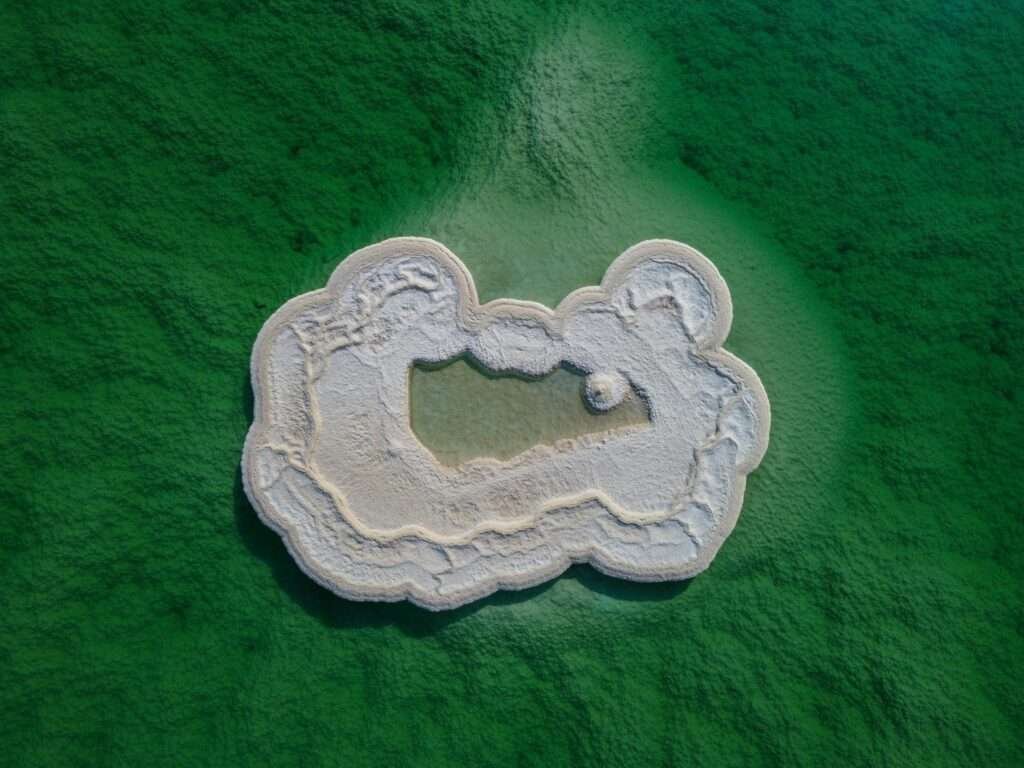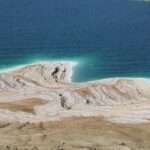The Dead Sea is particularly rich in magnesium. Its salts are roughly ~51% magnesium chloride (MgCl₂), and the water typically contains about 35–46 grams of magnesium per liter—far above ocean levels. The lake also has the highest natural bromide concentration on Earth, adding to its distinctive properties and spa reputation.
Why This Question Matters
People ask this because “what mineral dominates?” determines why the Dead Sea feels oily-silky, why it stings cuts, why it’s so buoyant, and why industries harvest it. In typical seawater, sodium chloride makes up ~85% of salts. In the Dead Sea, however, magnesium chloride is king. This flip in chemistry sets up genuine differences in health uses, industrial production, and visitor experience.
Understanding the mineral mix also clarifies common myths. For example, Dead Sea salt used for soaking is not the same as table salt, and it’s not meant for eating. Its composition varies with season, depth, and evaporation, but robust measurements consistently show magnesium and bromide standing out among the ions that make this lake unique.
Which Minerals Dominate the Dead Sea’s Waters?
Multiple surveys report that Dead Sea salt (the solid residue of its brine) is composed, on a weight-percent basis, of approximately ~50.8% magnesium chloride, ~30% sodium chloride, ~14% calcium chloride, and ~4–5% potassium chloride, with very low sulfate and notably high bromide among the anions. Typical surface-water concentrations (dissolved ions) include ~46 g/L magnesium, ~37 g/L sodium, ~18 g/L calcium, and ~8 g/L potassium, alongside ~230 g/L chloride + bromide. For accessibility, that ~46 g/L magnesium equals about 6.1 oz per US gallon of water—an enormous amount compared to oceans (<~0.13 oz/gal).
These values vary slightly with depth, temperature, and year, but the pattern remains: magnesium dominates among cations, and bromide is exceptionally high among anions. For accessible overviews and data tables, see: an updated reference profile on the Dead Sea and composition summaries indicating that the Dead Sea’s salt is about half magnesium chloride and contains the world’s highest natural bromide concentration; Britannica also notes strong concentrations of magnesium, potassium, chlorine, and bromine in deeper waters (Britannica overview).
Why magnesium dominates
As the sun evaporates water in this terminal lake, salts don’t precipitate all at once. Sodium chloride (halite) tends to crystallize and settle earlier, leaving the brine progressively richer in magnesium and calcium chlorides—a process called fractional crystallization. Over long periods, this process, plus inflow chemistry and climate, yields a magnesium-heavy brine and salt mix. Industrial harvesting takes advantage of this chemistry to separate salts efficiently.
Bromide: the world’s highest natural concentration
Besides magnesium, the Dead Sea boasts the highest bromide levels found in natural waters. Bromide is not just a curiosity; it affects taste, smell, and some therapeutic claims. Deep water also contains hydrogen sulfide and has higher overall salinity (roughly 332‰ in classic profiles), which influences stratification and seasonal mixing in the lake.
| Ion / Metric | Typical Concentration |
|---|---|
| Chloride + Bromide | ≈230.4 g/L (≈30.8 oz/US gal) |
| Magnesium (Mg²⁺) | ≈45.9 g/L (≈6.1 oz/US gal) |
| Sodium (Na⁺) | ≈36.6 g/L (≈4.9 oz/US gal) |
| Calcium (Ca²⁺) | ≈17.6 g/L (≈2.3 oz/US gal) |
| Potassium (K⁺) | ≈7.8 g/L (≈1.0 oz/US gal) |
| Sulfate (SO₄²⁻) | ≈0.4 g/L (≈0.05 oz/US gal) |
| Bicarbonate (HCO₃⁻) | ≈0.2 g/L (≈0.03 oz/US gal) |
Notes: Figures represent typical surface-water values; composition varies by season, depth, and long-term level changes. Ocean water, by contrast, is ~85% sodium chloride by salt mass; the Dead Sea’s salt is only ~30% NaCl and ~50% MgCl₂.
Proven & Probable Benefits — What the Evidence Shows
Skin barrier & inflammation: In a controlled clinical trial, bathing hands in a magnesium-rich Dead Sea salt solution improved skin hydration, reduced roughness, and lowered inflammation markers in atopic dry skin after just two weeks. This strongly supports the idea that magnesium ions help restore the skin barrier and calm irritation. See the peer-reviewed trial in the International Journal of Dermatology.
Broader skincare and climate therapy: Recent reviews summarize that Dead Sea water and derived complexes can aid moisturization, barrier repair, anti-inflammation, and anti-aging mechanisms. Dermatologists often recommend “Dead Sea climate therapy” for psoriasis and eczema under medical guidance. For an overview, see an open-access 2023 review (MDPI: Cosmetics), which aggregates in vitro, in vivo, and clinical observations.
Dermatology trials (magnesium-rich solutions)
The well-cited 2005 trial used a 5% Dead Sea salt solution enriched in magnesium. Participants experienced significantly better stratum corneum hydration and reduced transepidermal water loss compared with tap water—a direct magnesium effect consistent with the lake’s magnesium dominance.
Climate therapy and broader reviews
Therapeutic programs at the Dead Sea combine sun exposure (with relatively lower UVB), mineral bathing, and rest. Reviews conclude benefits for chronic skin disease, but emphasize medical supervision and realistic expectations. Benefits are supportive rather than curative, and individual responses vary.
From Lake to Industry: Potash, Bromine & Magnesium
The Dead Sea’s chemistry underpins major mineral industries on both shores. As brine concentrates in evaporation ponds, a mixed potassium-magnesium salt called carnallite (KMgCl₃·6H₂O) forms. Processing carnallite yields potash (KCl) for fertilizer and magnesium chloride for multiple uses, while the brine’s high bromide levels support a large bromine industry. A U.S. Agricultural Marketing Service technical review notes that magnesium chloride accounts for about half of Dead Sea solids, explaining why Mg is repeatedly identified as the standout mineral (USDA AMS technical report).
General-audience summaries likewise emphasize that, unlike most seas, the Dead Sea is not NaCl-dominated. For composition context and hydrology, see Encyclopædia Britannica’s Dead Sea profile. These industrial realities also influence regional economies and environmental debates as lake levels change over time.
Carnallite and extraction, in brief
Because halite (NaCl) crystallizes earlier, late-stage brines become Mg- and K-rich. This allows solar-pond operators to skim off carnallite efficiently, then leach and separate to produce KCl fertilizer and MgCl₂ feedstocks. Bromine is recovered from brine streams where its concentration is among the world’s highest.
Safety & Practical Tips (Visitors and Home Use)
Do not ingest Dead Sea salt or water. Its magnesium, calcium, and bromide levels make it unsuitable as food. Keep water out of eyes and mouth. If you float in the lake, enter slowly, avoid shaving the same day, and rinse with fresh water afterward. Deep water is around 72 °F (22 °C), and the salinity is roughly 31–34% by weight, so floating is effortless—but stinging on cuts is real.
At home, bath products labeled “Dead Sea salt” are meant for soaking only. Follow package directions, and stop if skin stings excessively. People with specific conditions (e.g., kidney issues, pregnancy, or skin breaks) should consult a clinician before extended soaking. Finally, remember that topical benefits do not mean systemic mineral supplementation; bath soaks are about the skin barrier, not nutrition.
FAQ
Which mineral is the Dead Sea particularly rich in?
Magnesium. Dead Sea salts are about ~50.8% magnesium chloride by weight of anhydrous chlorides, and the water commonly contains about 35–46 g/L of magnesium—orders of magnitude above ocean water. Bromide is also exceptionally high.
Is Dead Sea salt the same as table salt?
No. Typical seas are ~85% sodium chloride. Dead Sea salt is only ~30% NaCl and ~50% MgCl₂, with significant calcium and potassium chlorides. This is why it feels different on skin and is not used as a food salt.
What health benefits have the strongest evidence?
Controlled trials show magnesium-rich Dead Sea salt solutions can improve hydration and reduce inflammation in dry or atopic skin. Reviews also support dermatologist-supervised climate therapy for some skin diseases. Benefits vary by person; they are adjuncts, not cures.
Why does the Dead Sea sting cuts and eyes more than the ocean?
Very high salinity (about 31–34% by weight) and abundant divalent ions (Mg²⁺, Ca²⁺) irritate tissues. Even a splash in the eye can be painful; rinse with fresh water immediately.
What Did We Learn Today?
- The Dead Sea is magnesium-rich; its salts are ~50.8% MgCl₂.
- Typical water holds about 45.9 g/L magnesium (~6.1 oz/US gal).
- It also has the highest natural bromide levels among waters.
- Dermatology trials support skin barrier benefits from magnesium-rich soaks.
- Industry extracts potash, bromine, and magnesium via solar ponds and carnallite.





